Honda Introduces Next-generation Technologies for Honda 0 Series Models at Honda 0 Tech Meeting 2024
TOKYO, Japan, October 9, 2024 – Honda Motor Co., Ltd. today held its “Honda 0 Tech Meeting 2024” and introduced some of the next-generation technologies to be applied to the Honda 0 Series, a completely new EV series Honda is planning to launch in the global market starting in 2026.
The Honda 0 Series is being developed with new ideas Honda is generating from “zero” with a new approach to EV development – “Thin, Light, and Wise.” With this development approach, Honda will offer five core values through its EVs.
1) Artistic design that resonates with people
2) Automated Driving/Advanced Driver Assistance Systems (AD/ADAS) that ensures safety and peace of mind
3) New value of EV as a “space” for people made possible by the internet of things (IoT) and connected technologies
4) The joy of driving with the feeling of oneness with the vehicle
5) Outstanding electricity efficiency performance
At CES 2024 held in Las Vegas, Nevada, U.S. in January of this year, Honda unveiled two concept models of the Honda 0 Series, the Saloon and the Space-Hub. Honda also announced plans to launch a production model of the Saloon in 2026. This production model will be close to the Saloon concept model, and it will be positioned as the flagship model of the Honda 0 Series. Moreover, Honda has also announced plans to introduce a total of seven Honda 0 Series models globally by 2030, including small-, medium- and large-size models.
Honda is planning to unveil a new Honda 0 Series model at CES 2025, scheduled to be held in January 2025. This new model will be the embodiment in product form of the technologies and electrification concept introduced during the Honda 0 Tech Meeting.
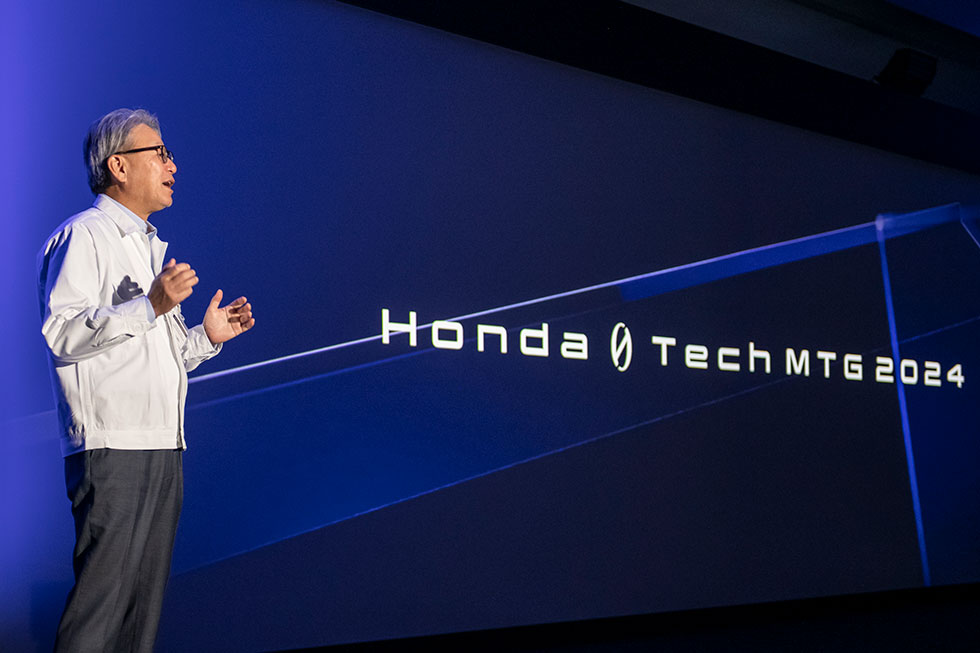
<Next-generation technologies introduced at the Honda 0 Tech Meeting>
Thin and Light
With the “Thin” development approach, Honda will continue to value and realize the M/M (Man Maximum, Machine Minimum) concept in this EV era and strive to offer new value of EVs as a comfortable “space” featuring an original styling design with a low vehicle height and short overhangs.
With the “Light” development approach, Honda will strive to realize both sporty driving unique only to Honda and the world’s top-class electricity efficiency performance, which Honda has always been committed to doing in its car-making.
Newly developed dedicated EV platform
Adopting the 2.0 GPa grade hot stamping material (ultra-high strength steel plate), Honda developed a new EV platform to realize both thin and low-height styling, as well as the safety and peace of mind of the occupants. In addition, combined with the adoption of a thin battery pack and a newly developed compact e-Axle, the original Honda low-floor technology enables a low center of gravity and low inertia by placing heavy components low and in the center of the vehicle. This stabilizes vehicle behavior and enables a sporty driving.
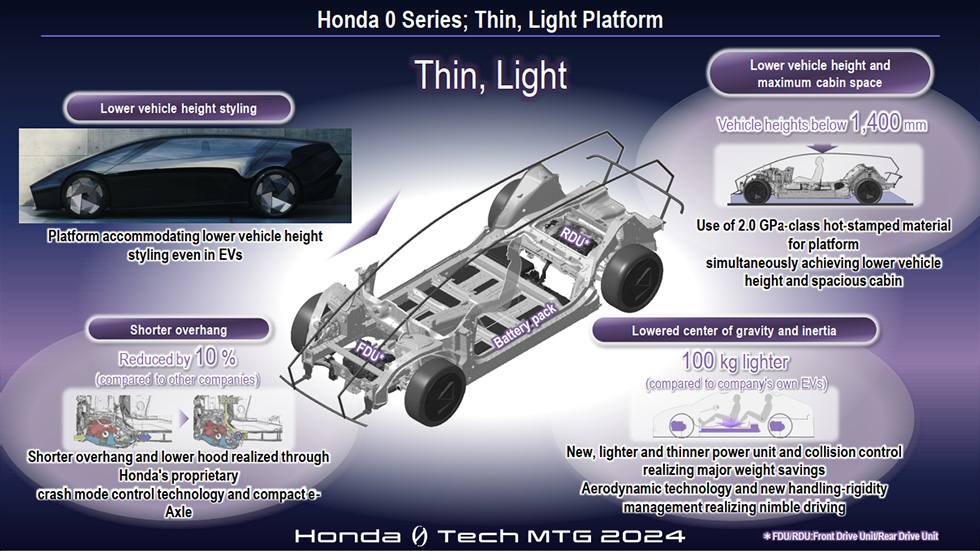
Newly-developed compact e-Axle
The motor and inverter technologies Honda has amassed through the development of hybrid-electric vehicles (HEVs) will be utilized in EVs to realize a compact and highly efficient e-Axle. The inverter was downsized by approximately 40%*1, which made it possible to achieve a horizontal layout package where the inverter is placed side by side with the motor, something that has been difficult to achieve in the past. With this compact e-Axle, the low-height styling and maximizing of cabin space will be achieved at the same time.
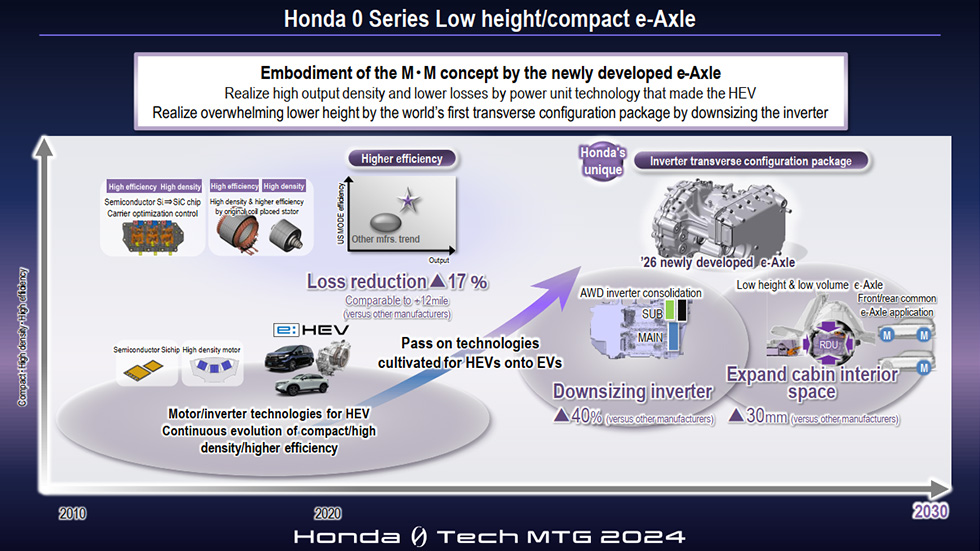
Thin battery pack
The IPU (battery) case will be made approximately 6% thinner*1 through the adoption of Megacasting and 3D friction stir welding (FSW) technology. In addition, by adopting a body structure which is designed to disperse the impact of a collision, the extra space needed to protect the battery will be reduced, which will result in a larger area available for mounting a battery. With these technologies, a lighter and thinner battery pack will be installed with maximum efficiency, contributing to an extension of the range for Honda 0 Series models.
Furthermore, Honda is striving to limit the degradation of battery capacity (range) to less than 10% after 10 years of use by applying battery degradation diagnosis and prediction technology that utilizes driving data from 5 million Honda vehicles, mostly HEVs.
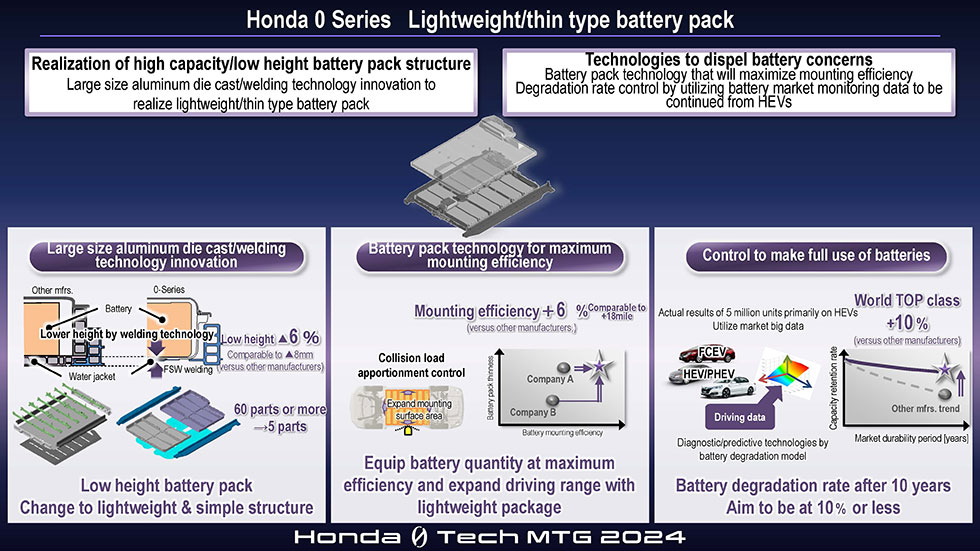
Active aerodynamic system
Honda has developed an active aerodynamic system that will automatically activate the front aero deflector according to the vehicle speed and other factors. The front aero deflector is installed under the floor to reduce air resistance for all vehicle body types including the ones with high vehicle height or with styling that are susceptible to air resistance, such as SUVs. In addition to reducing driving energy without compromising daily usability, this system will enable the vehicle to demonstrate high downforce performance and contribute to an increase in straight-line stability of the vehicle.
New body rigidity management to realize high driving stability and lightweight
A sporty and exhilarating driving experience will be achieved by adopting a new steering stability index, which provides the ability to flex the vehicle body to control load on each tire during cornering. The simplified body structure also contributes to an overall vehicle weight reduction of approximately 100kg (220 pounds) compared to initial Honda EVs.

Production technologies to make “Thin” and “Light” possible
Advancement of the Intelligent Power Unit (IPU) case production technologies
A 6,000-ton class megacasting (high-pressure, high-precision casting) machine will be adopted to the IPU (battery) case production line, which will significantly reduce the number of parts from more than 60 to 5. In addition, by joining a dedicated IPU case part, which is different for each EV model size, and a common part with FSW technology, a variety of IPU cases can be produced efficiently. This will improve overall production efficiency and limit the required capital investment. Honda will continue to advance these production technologies, including the expansion of the application to large aluminum casting body frame parts in the future.
Advancement of technologies to realize a lighter vehicle body
The application of the world's first*2 CDC joining technology*3 will enable the expansion of the range of use of lightweight and high-strength materials. This will improve electricity efficiency performance through the reduction of the body frame weight and enhance passive safety performance at the same time.
Advancement of production method on battery pack assembly line
For the battery pack assembly line, a newly-developed cell production system will be adopted to achieve both high production efficiency and flexibility. The Honda flex-cell production system, where multiple cells are connected by AGVs (automatic guided vehicles) and production processes can be combined flexibly, will enable flexible adjustments to changes in production models and fluctuations in production volume.
Wise
By applying the knowledge that Honda has amassed to date and by further advancing its intelligent technologies, Honda will create original software-defined vehicles (SDVs) and make the vehicles themselves wiser. To be more specific, Honda will develop its original vehicle OS, then, in line with the advancement of connected technologies, strive to offer new mobility experiences to customers by applying intelligent technologies optimized for each customer.
Even after the customer purchases the vehicle, Honda will continuously add/upgrade vehicle functions through OTA (Over the Air) updates and advance the vehicle into more attractive product unique to Honda.
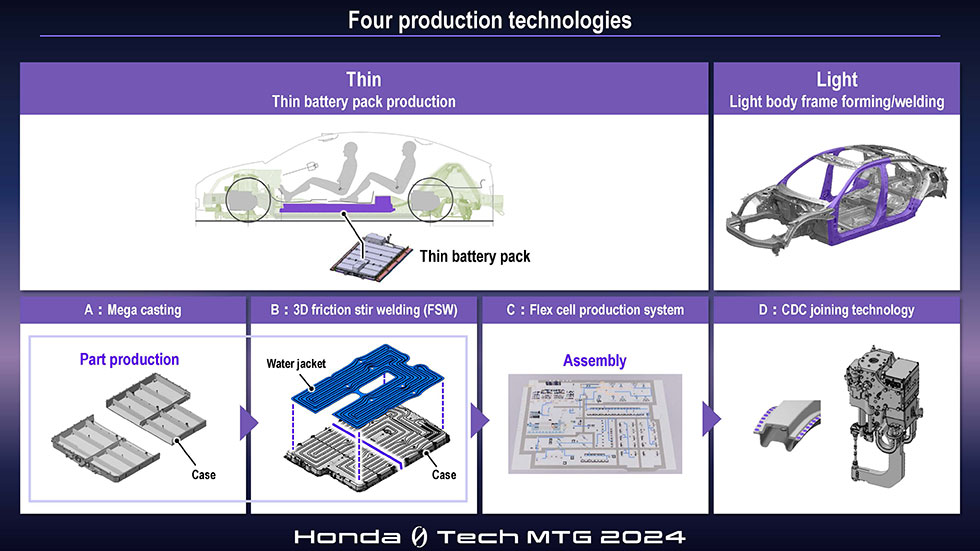
Four focus items Honda will pursue with the “Wise” development approach
●AD/ADAS (Automated Driving/Advanced Driver Assistance Systems)
Honda is developing its AD/ADAS with an aim to offer “experiences that make people want to go out more spontaneously” by supporting safe and seamless mobility which people can enjoy with peace of mind, not only while driving but for the entire way from home to their destination.
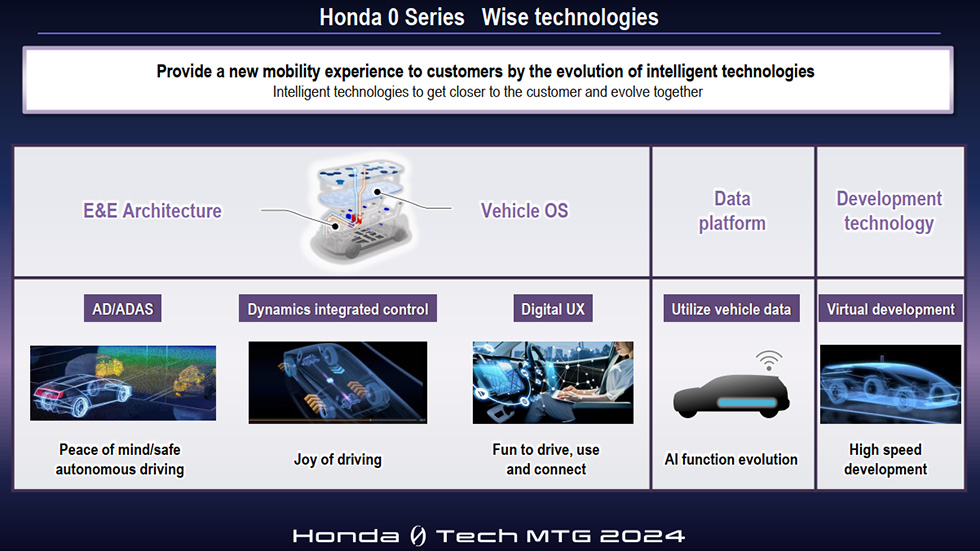
In 2021, Honda put Level 3 automated driving equipment into practical use with the launch of the all-new Legend equipped with Honda SENSING Elite, which qualified for Level 3 automated driving (eyes-off), conditional driving automation in limited areas. The Honda 0 Series models will feature AD/ADAS technologies that utilize the Level 3 technologies to offer more affordable automated driving vehicles to more customers. Moreover, Honda 0 Series models will be equipped with a system that enables the expansion of the range of driving conditions where driver assistance and Level 3 automated driving (eyes-off) will be available. This expansion will start with eyes-off technology available in traffic congestion on highways, then will continue through the OTA updates of the functions. Honda is further advancing its AD/ADAS technologies, such as LiDAR-based high-precision and highly-reliable sensing, high-definition camera sensing of all surroundings, and installation of a high-performance ECU compatible with Honda original AI and sensor fusion.
In addition, original Honda AI technology that combines the unsupervised learning*4 technology of the U.S.-based Helm.ai and the behavior models of experienced drivers, which enable AI to learn with smaller amounts of data, and provide highly accurate driver assistance. This will enable the system to accurately predict risks and smoothly avoid them, even while driving on roads that are new to the driver/vehicle, enabling Honda to quickly expand the range of automated driving and driver assistance.
By advancing this technology, Honda will strive to be the first company in the world to expand the application of eyes-off functions to all driving situations and provide safer AD/ADAS which offer greater peace of mind for the customers.
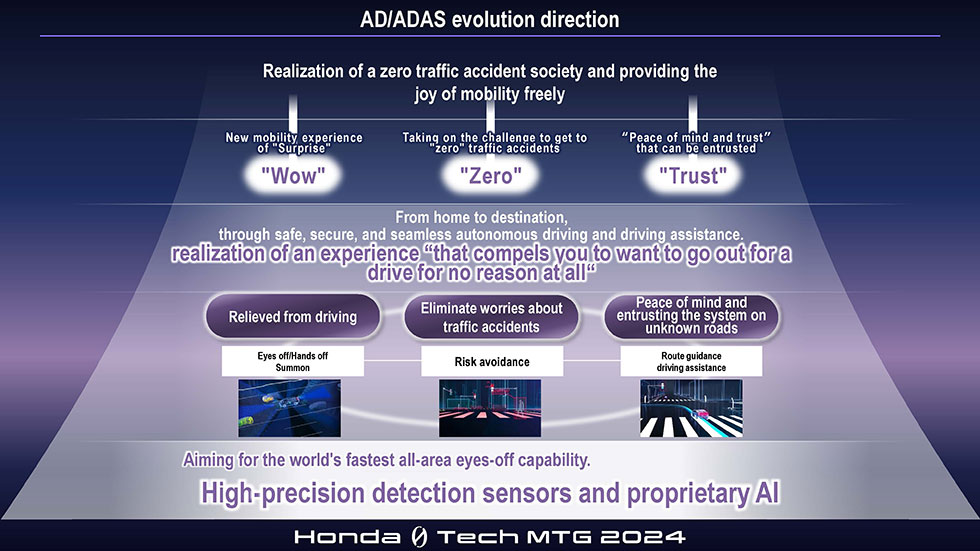
●The Joy of Driving
While advancing automated driving technology to realize greater safety and peace of mind, Honda is also advancing its original technology for integrated control of vehicle dynamics, which seamlessly connect various control technologies. With that, Honda is striving to offer the “joy of driving” unique to the next-generation EVs which will realize a sporty and uplifting feeling that comes from a sense of oneness the driver feels with the vehicle with both mind and body. By adopting a steer-by-wire system, an integrated control will be applied to all by-wire devices such as the steering wheel, suspensions and brakes, which will enable handling at the will of the driver.
In addition, by applying high-precision attitude estimation and stabilization control based on 3D gyro sensors, which Honda has amassed through the development of original robotics technologies, vehicle behavior will be stabilized before it becomes unstable to achieve smooth turning. During acceleration, the electric motor and brake system will work together to control tire grip promptly and accurately, ensuring stable and comfortable acceleration on various types of road surfaces.
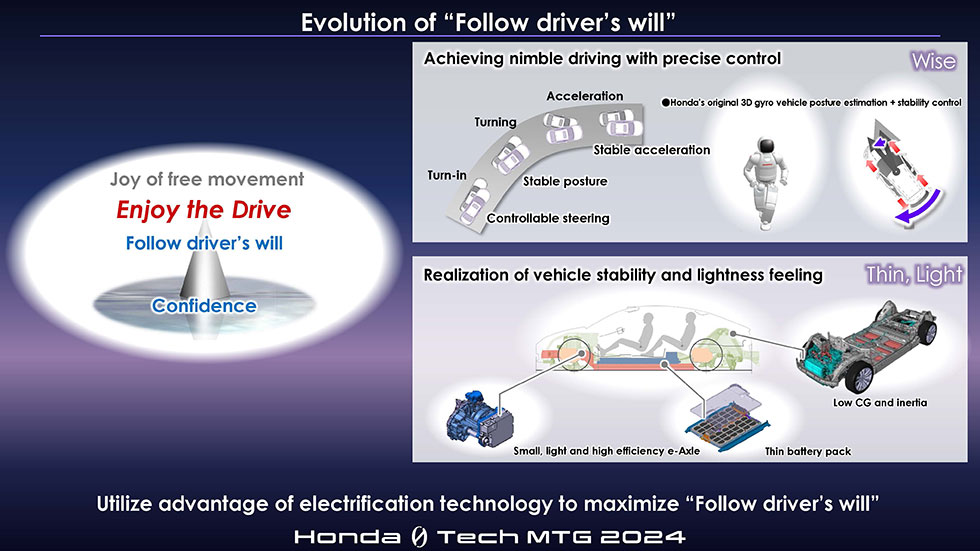
●Energy management
By combining battery management technology, developed originally for HEVs, with the newly developed thermal management technology which includes thermal management of the battery, the Honda 0 Series models will offer a comfortable cabin space and highly practical range to accommodate the way the customers use their vehicles. Specifically, by making the power unit more efficient, a range in the 300-mile class in EPA mode will be achieved.
Moreover, in order to cope with winter weather, when the decline in range due to the use of the heater and other equipment is a concern, the vehicles will realize both comfort and energy saving by using a human-centric temperature sensitivity index. With the use of a radiant heater, which warms the cabin space with radiant heat, and highly efficient operation of the heat pump, the energy consumption will be minimized by reducing power consumption of heating equipment by approximately 13%*1.
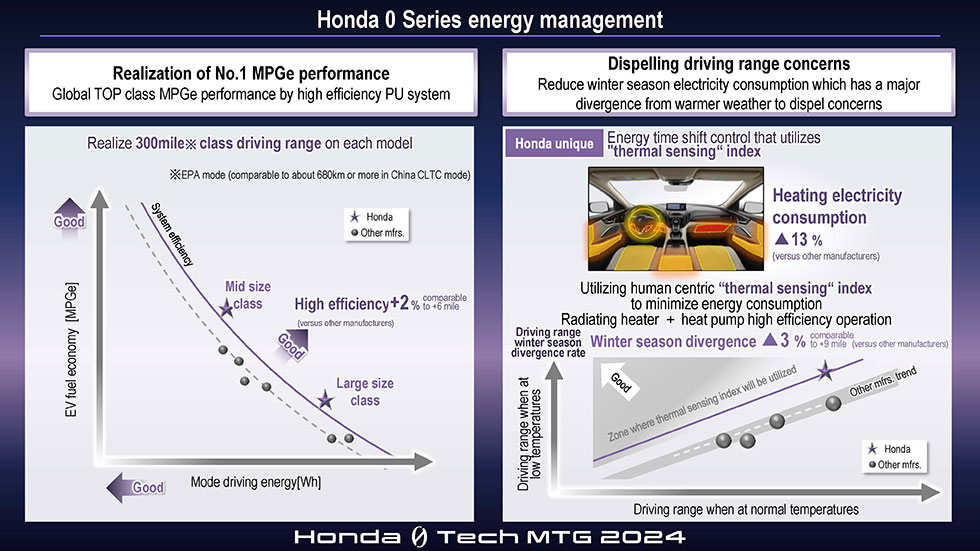
●Digital User Experience (UX)
Through the use of intelligent and digital technologies, Honda is striving to offer new and inspiring EV-based mobility experiences, while minimizing user stress and maximizing the driving and in-vehicle enjoyment. To offer a stress-free in-vehicle experience for customers, Honda will thoroughly simplify operation of the in-vehicle infotainment (IVI) system and continuously advance the support with the voice assistant personalized for each customer. In addition, with enhanced understanding of the situation based on image recognition and the utilization of an original Honda behavior prediction algorithm, the vehicle will become capable of understanding the situation and the intention of the user and proactively offering suggestions and support optimized for each customer.
As for driving and in-vehicle enjoyment, Honda will utilize rapidly advancing IT technologies ahead of the times and offer a wide range of content, including not only 1) entertainment services to make EVs more fun as a “space” for mobility, but also 2) content that will offer more fun for users who enjoy driving, and 3) a “virtual ride-sharing experience” which will connect the occupants and people who are not in the vehicle using XR (extended reality) technology*5.
Through these digital UX technologies, Honda will create the “fun of driving, using, and being connected” for its next-generation EVs.
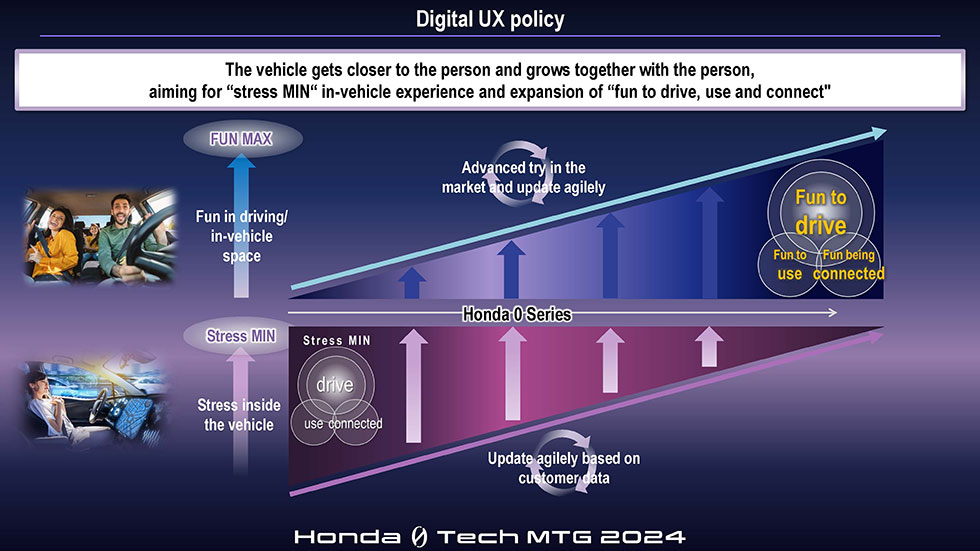
The details of the Honda 0 Tech Meeting 2024 and the technologies explained at the event will be available on the following Honda websites:
Honda technology site:
https://global.honda/jp/tech/ (Japanese)
Honda 0 brand site:
https://0.honda/jp/ (Japanese)
https://0.honda/en/ (English)
Compared to the standard component/function installed in currently available production EVs. (Honda internal research)
Honda internal research
Constant Direct Current Chopping: Honda original technology for welding multiple materials of different thickness,
Unsupervised learning is one of the methods of machine learning, which supports AI. Unlike supervised learning through which AI learns the correct answers to derive from labeled input data, unsupervised learning lets AI learn without being provided with the correct answers and derives the patterns and unique characteristics of the unlabeled data on its own.
Technology that merges physical reality and virtual spaces to create new experiences.